Dingding Liang
A microwave photonic prototype for concurrent radar detection and spectrum sensing over an 8 to 40 GHz bandwidth
Jun 20, 2024



Abstract:In this work, a microwave photonic prototype for concurrent radar detection and spectrum sensing is proposed, designed, built, and investigated. A direct digital synthesizer and an analog electronic circuit are integrated to generate an intermediate frequency (IF) linearly frequency-modulated (LFM) signal with a tunable center frequency from 2.5 to 9.5 GHz and an instantaneous bandwidth of 1 GHz. The IF LFM signal is converted to the optical domain via an intensity modulator and then filtered by a fiber Bragg grating (FBG) to generate only two 2nd-order optical LFM sidebands. In radar detection, the two optical LFM sidebands beat with each other to generate a frequency-and-bandwidth-quadrupled LFM signal, which is used for ranging, radial velocity measurement, and imaging. By changing the center frequency of the IF LFM signal, the radar function can be operated within 8 to 40 GHz. In spectrum sensing, one 2nd-order optical LFM sideband is selected by another FBG, which then works in conjunction with the stimulated Brillouin scattering gain spectrum to map the frequency of the signal under test to time with an instantaneous measurement bandwidth of 2 GHz. By using a frequency shift module to adjust the pump frequency, the frequency measurement range can be adjusted from 0 to 40 GHz. The prototype is comprehensively studied and tested, which is capable of achieving a range resolution of 3.75 cm, a range error of less than $\pm$ 2 cm, a radial velocity error within $\pm$ 1 cm/s, delivering clear imaging of multiple small targets, and maintaining a frequency measurement error of less than $\pm$ 7 MHz and a frequency resolution of better than 20 MHz.
Photonics-Assisted Joint Communication-Radar System Based on a QPSK-Sliced Linearly Frequency-Modulated Signal
Jan 28, 2022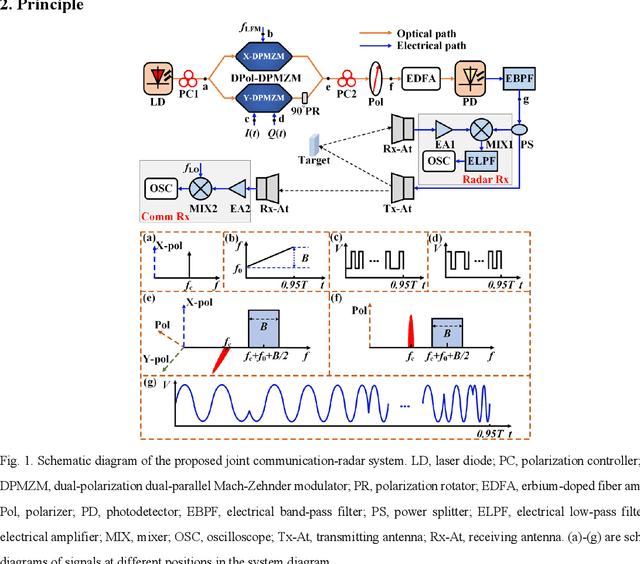
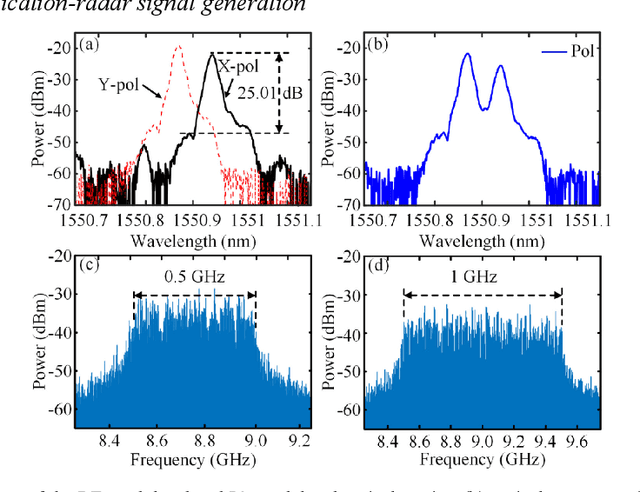
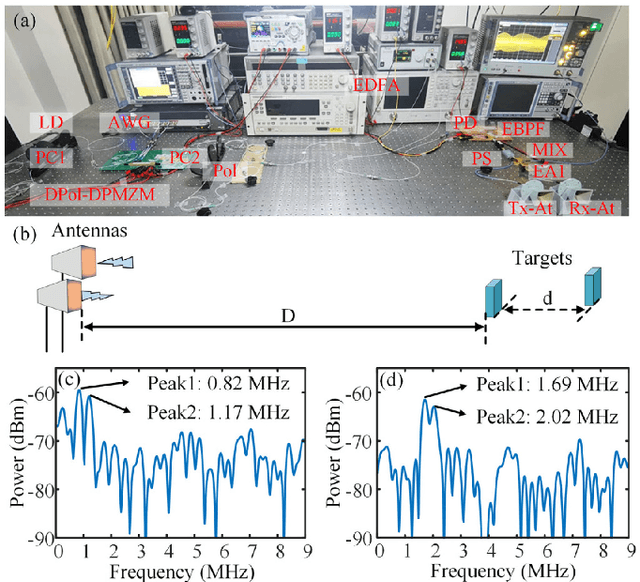
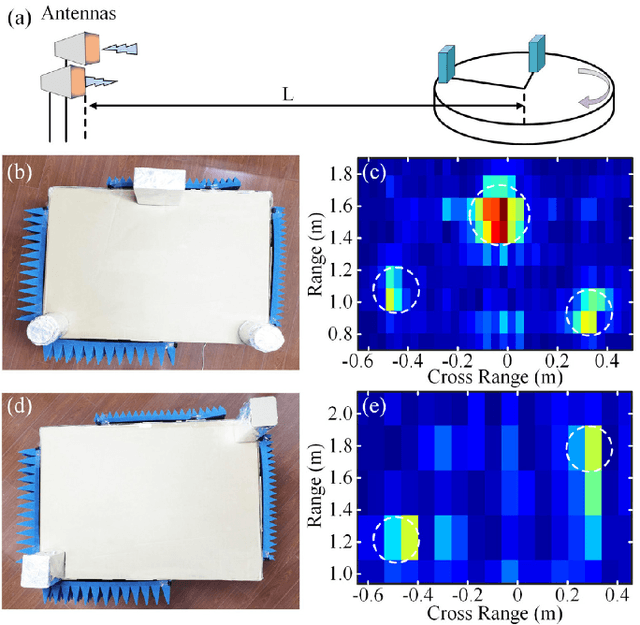
Abstract:A photonics-assisted joint communication-radar system is proposed and experimentally demonstrated, by introducing a quadrature phase-shift keying (QPSK)-sliced linearly frequency-modulated (LFM) signal. An LFM signal is carrier-suppressed single-sideband modulated onto the optical carrier in one dual-parallel Mach-Zehnder modulator (DPMZM) of a dual-polarization dual-parallel Mach-Zehnder modulator (DPol-DPMZM). The other DPMZM of the DPol-DPMZM is biased as an IQ modulator to implement QPSK modulation on the optical carrier. The polarization orthogonal optical signals from the DPol-DPMZM are further combined and detected in a photodetector to generate the QPSK-sliced LFM signal, which is used to realize efficient data transmission and high-performance radar functions including ranging and imaging. An experiment is carried out. Radar range detection with an error of less than 4 cm, ISAR imaging with a resolution of 14.99 cm*3.25 cm, and communication with a data rate of 105.26 Mbit/s are successfully verified.
Photonics-based de-chirping and leakage cancellation for frequency-modulated continuous-wave radar system
Nov 12, 2021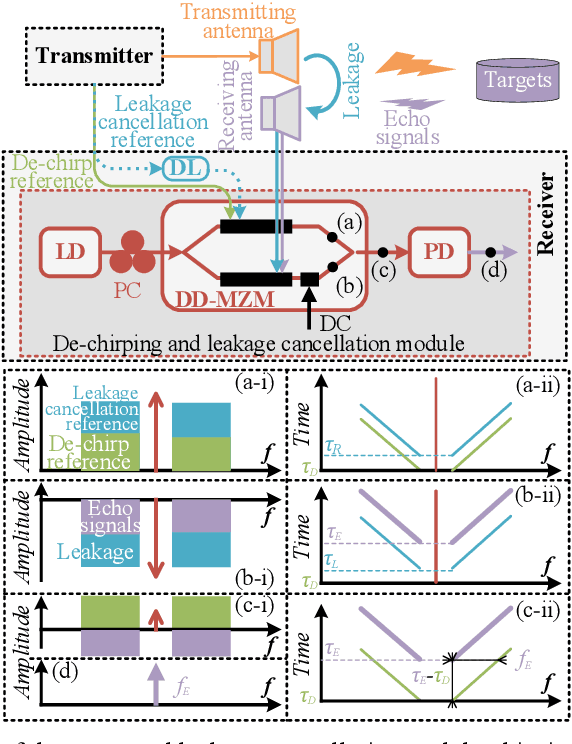
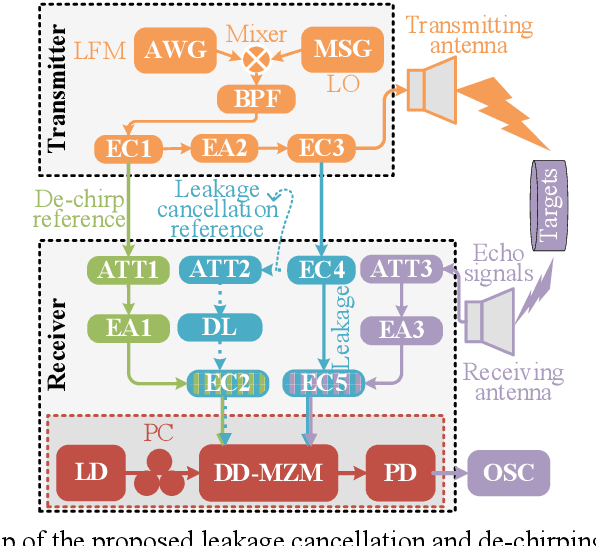
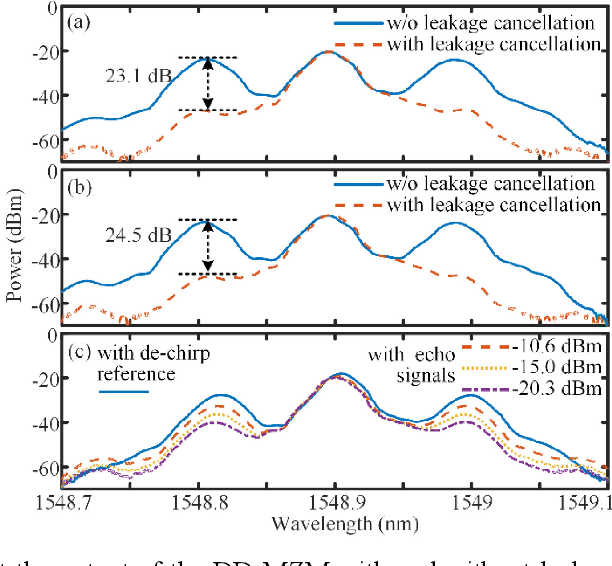
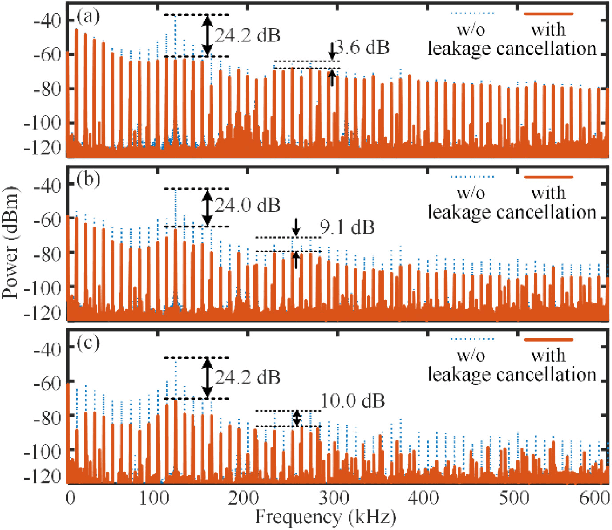
Abstract:A photonics-based leakage cancellation and echo signal de-chirping approach for frequency-modulated continuous-wave radar systems is proposed based on a dual-drive Mach-Zehnder modulator (DD-MZM), with its performance evaluated by the radar measurement and imaging. The de-chirp reference signal and the leakage cancellation reference signal are combined and applied to the upper arm of the DD-MZM, while the received signal including the leakage signal and echo signals is applied to the lower arm of the DD-MZM. When the amplitudes and delays of the leakage cancellation reference signal and the leakage signal are precisely matched and the DD-MZM is biased at the minimum transmission point, the leakage signal is canceled in the optical domain. The de-chirped signals are obtained after the leakage-free optical signal is detected in a photodetector. An experiment is performed. The cancellation depth of the de-chirped leakage signal is around 23 dB when the center frequency and bandwidth of the linearly frequency-modulated signal are 11.5 and 2 GHz. The leakage cancellation scheme is used in a radar system. When the leakage cancellation is not employed, the leakage signal will seriously affect the imaging results and distance measurement accuracy of the radar system. When the leakage cancellation is applied, the imaging results of multiple targets can be clearly distinguished, and the error of the distance measurement results is significantly reduced to 10 cm.
Multi-functional microwave photonic radar system for simultaneous distance and velocity measurement and high-resolution microwave imaging
May 27, 2021



Abstract:A photonic-assisted multi-functional radar system for simultaneous distance and velocity measurement and high-resolution microwave imaging is proposed and experimentally demonstrated by using a composite transmitted microwave signal of a single-chirped linearly frequency-modulated (LFM) signal and a single-tone microwave signal. In the system, the transmitted signal is generated via photonic frequency up-conversion based on a single integrated dual-polarization dual-parallel Mach-Zehnder modulator (DPol-DPMZM), whereas the echo signals scattered from the target are de-chirped to two low-frequency signals using a microwave photonic frequency mixer. By using the two low-frequency de-chirped signals, the real-time distance and radial velocity of the moving target can be measured accurately according to the round-trip time of the echo signal and its Doppler frequency shift. Compared with the previous reported distance and velocity measurement methods, where two LFM signals with opposite chirps are used, these parameters can be obtained using only a single-chirped LFM signal and a single-tone microwave signal. Meanwhile, high-resolution inverse synthetic aperture radar (ISAR) imaging can also be realized using ISAR imaging algorithms. An experiment is performed to verify the proposed multi-functional microwave photonic radar system. An up-chirped LFM signal from 8.5 to 12.5 GHz and an 8.0 GHz single-tone microwave signal are used as the transmitted signal. The results show that the absolute measurement errors of distance and radial velocity are less than 5.9 cm and 2.8 cm/s, respectively. ISAR imaging results are also demonstrated, which proves the high-resolution and real-time ISAR imaging ability of the proposed system.
 Add to Chrome
Add to Chrome Add to Firefox
Add to Firefox Add to Edge
Add to Edge